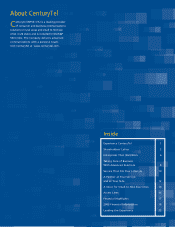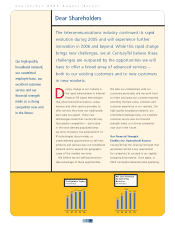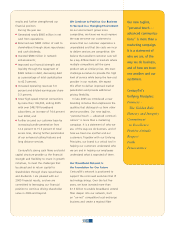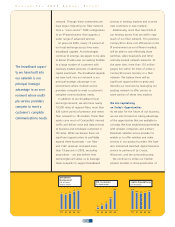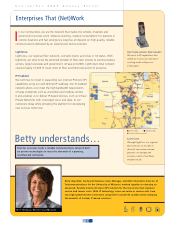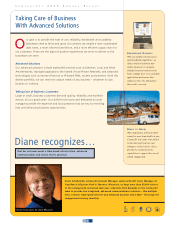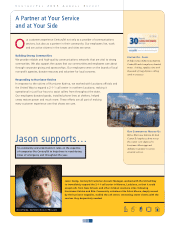CenturyLink 2005 Annual Report Download - page 6
Download and view the complete annual report
Please find page 6 of the 2005 CenturyLink annual report below. You can navigate through the pages in the report by either clicking on the pages listed below, or by using the keyword search tool below to find specific information within the annual report.
4
CENTURYTEL 2005 ANNUAL REPORT
01 02 03 04 05
61 59 63
71 75
Broadband
Deployment
(% of total
access lines)
01 02 03 04 05
25
53
83
143
249
DSL Customers
(in thousands)
01 02 03 04 05
436
386 378 385 415
Capital Expenditures
(in millions)
The broadband capaci-
ty we have built into
our network is our
principal strategic
advantage in an envi-
ronment where multi-
ple service providers
compete to meet a
customer’s complete
communications needs.
network. Through these investments we
have begun migrating our fiber network
from a “voice-centric” TDM configuration
to an IP-based system that supports a
wider range of advanced services.
At year-end 2005, nearly 75 percent of
our local exchange access lines were
broadband capable. As technologies
continue to emerge, we expect to be able
to deliver IP-video over our existing facilities
to a large number of customers with
relatively modest amounts of additional
capital investment. The broadband capacity
we have built into our network is our
principal strategic advantage in an
environment where multiple service
providers compete to meet a customer’s
complete communications needs.
In addition to our broadband local
exchange network, we also have nearly
10,500 miles of regional fiber, more than
630 carrier points of presence and metro
fiber networks in 18 markets. These fiber
assets carry much of CenturyTel’s internal
traffic and deliver voice and data services
to business and wholesale customers in
18 states. While we believe there are
significant opportunities to profitably
expand these businesses – our fiber
and CLEC revenues increased more
than 19 percent in 2005, excluding
acquisitions – we also believe new
technologies will allow us to leverage
these networks to support broadband
services in existing markets and to serve
new customers in new markets.
Additionally, more than two-thirds of
our existing access lines are within easy
reach of our fiber network. This positions
CenturyTel to drive cost efficiencies in the
IP environment as our different markets
will be able to cost-effectively share
switches, video head-ends and other
centrally located network elements. At
the same time, more than 155 million
people live within 50 miles of either a
CenturyTel service territory or a fiber
network. We believe there will be
significant opportunities to grow and
diversify our revenues by leveraging our
existing network to offer service to
some portion of these new markets.
We Are Capitalizing
on Today’s Opportunities
As we plan for the future of our business,
we are also focused on taking advantage
of the opportunities that are available to
us today. We have established partnerships
with wireless companies and a Direct
Broadcast Satellite service provider to
enable us to offer wireless and video
services in our product bundles. We have
also introduced switched digital television
service to portions of La Crosse,
Wisconsin, and the surrounding area.
We continue to utilize our flexible
product bundles to drive penetration of


